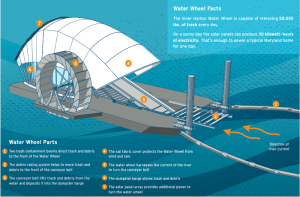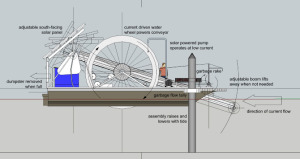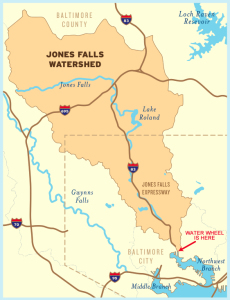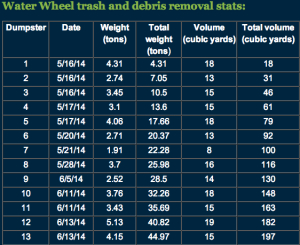Solar Water Wheel Skimmer

…or, what else to call it? Its inventor, John Kellett, has several names for it, including “trash mill.” On the Healthy Harbor website it’s called “Inner Harbor Waterwheel.” (Healthy Harbor’s an initiative of the Waterfront Partnership of Baltimore, Inc.)
This solar-powered trash mill is “anchored” in Baltimore’s Inner Harbor at the outfall of the Jones Falls Watershed where the waterwheel operates from the current at the outfall, or the back-up solar PV array on board. The rig was designed by a local architect firm to Kellett’s specs. It’s capable of collecting up to 50,000 lbs. of trash/day.

 Believe it or not, Kellett claims his trash mill evokes images of late 19th c. mill buildings along the Jones Falls. Could be heavily derived from the water wheel feature/component? Anyway, some of the Jones Falls mill buildings do remain, having been rehabilitated and adaptively reused as offices, showrooms, a bakery, other light manufacturing and a squash club, etc.
Believe it or not, Kellett claims his trash mill evokes images of late 19th c. mill buildings along the Jones Falls. Could be heavily derived from the water wheel feature/component? Anyway, some of the Jones Falls mill buildings do remain, having been rehabilitated and adaptively reused as offices, showrooms, a bakery, other light manufacturing and a squash club, etc.
Depending on the viewing angle, one might rather conjure a Conestoga wagon with over-sized wheels? The sail fabric shields the on-board trash dumpster underneath from rain and wind blowing the collected debris back into the water.
What brought this contraption to my attention was an article, “Pollution Revolution,” in the Summer 2014 edition of the Chesapeake Bay Foundation’s member-only “Save the Bay” magazine.
CBF Baltimore Initiative director Terry Cummings penned the piece. He asks the rhetorical question: “…can a water wheel save the harbor?” No, of course a single trash mill operating in the Inner Harbor can’t clean it up. He goes on to say that “one wheel, no matter how innovative and efficient, can’t possibly produce a swimmable harbor by 2020” which is mandated by Maryland and the federal government under the Chesapeake Bay Clean Water Blueprint.
Here’s a video that shows how the trash mill works and the “why” of certain design features-
Cummings also reports that recent MD Department of the Environment regulations include that Baltimore “reduce polluted runoff coming from 4,000 paved or otherwise hardened acres of land within the city by the end of 2018.”
The CBF says “just 1 inch of rain falling on 1 acre of paved surface equals 27,000 gallons of polluted runoff.” One offset to this is planting new trees where a single leafy-green tree can absorb 500-2,000 gal./yr. of rainwater and a single evergreen can absorb more than 4,000/gal/yr. (CBF “Polluted Runoff,” 1/2014)
There’s more to take in about the Jones Fall Watershed, and the many tons of trash conveyed by stormwater from impervious surfaces well beyond the actual river.

Here’s what one trash mill has been doing for the Inner Harbor lately-

